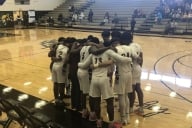You have /5 articles left.
Sign up for a free account or log in.
When people talk about the superfluous and sometimes nonsensical regulations in the National Collegiate Athletic Association’s 400-plus-page rulebook, one might first think of entries like the bagel rule, NCAA President Mark Emmert’s favorite example of overreach. That notorious rule, which Emmert has cited multiple times when explaining why he sought to deregulate the rulebook, stipulates that colleges may provide prospective athletes with bagels -- but not bagels with cream cheese -- when recruiting. The difference?
The former constitutes an allowable “snack” under NCAA rules, while the latter counts as an impermissible “meal.”
But the deregulation proposals up for a vote at this week’s NCAA convention are significantly less trivial than the bagel rule, with some experts suggesting that their (likely) approval would give the wealthiest programs even more of an advantage while changing the face of athletic recruiting.
On Saturday, the 18 college presidents who make up the Division I Board of Directors will consider 26 legislative changes designed to streamline the NCAA rulebook. The most significant shifts would allow for greater flexibility in recruiting by removing numerous restrictions on timing, frequency and forms of contact between coaches and athletes. Other rules would permit athletes more compensation for athletic-related expenses, eliminate restrictions on players' publicity and employment, and codify a new driving philosophy for NCAA rulemaking.
While the potential changes would undoubtedly simplify enforcement for colleges and the NCAA by scrapping regulatory laundry lists and leaving more decisions up to the discretion of campus officials, they could also put extra burdens on coaches and prospective athletes and expand the gap between the “have” and “have-not” programs.
“There are a bunch of rules in there that look like, at the very minimum, they’re going to benefit schools with a lot more money, with a lot more staff or better representation, right off the bat,” said John Infante, NCAA expert for the athletic recruiting website Athnet and author of the Bylaw Blog, which analyzes NCAA regulations and compliance.
The proposals are the recommendations of a Rules Working Group, one of the committees Emmert formed as part of his reform agenda to improve integrity, academic standards and financial sustainability in college sports.
“Some of our rules are counterintuitive, outdated and just unenforceable. They don’t make sense in the world we live in,” Emmert said in a press release. “We are refocusing on the things that really matter, the threats to integrity, and the biggest issues facing intercollegiate athletics.”
To do that, the working group set aside the notion of “competitive equity,” a guiding philosophy that sought to place all athletic programs on equal footing, and accepted that colleges with natural advantages – or “deeper pockets,” as the NCAA put it – will use them.
So, some of the proposals could face opposition from the less wealthy programs. However, the board of directors will likely approve most, if not all, of them anyway. Per NCAA legislative procedure, colleges that oppose the rules will then submit override requests, and if enough institutions sign on then there will be an override vote, which could overturn the rules in question. (That’s what happened with last year’s controversial proposals allowing multiyear scholarships and up to $2,000 in additional financial aid for athletes, though the former didn’t draw enough opposition to be cut.)
Division II is also considering a smaller "ease of burden" package, whose three proposals would lift some recruiting and amateurism restrictions.
Proposed rules like 13-3 -- which would eliminate existing restrictions on how colleges can get in touch with athletes they are recruiting, ending bans on text messaging and remove limits on the frequency of other forms of contact, like telephone calls -- would give those programs that can afford it free rein to court star athletes all day from all sides, if they want to. That prospect might drive the leaders of smaller, less wealthy programs to spend more on recruiting staff and related expenses in hopes of snatching up some of those athletes for themselves.
However, the coaches who have to do the actual legwork might not be up to the job, for reasons both practical (recruiting is already a time- and energy-sucking activity) and philosophical (a big part of the reason these rules existed in the first place was to respect the privacy of students). "I'm a fan of where we're at right now," Northwestern coach Pat Fitzgerald told ESPN last week. "I do not believe the system is broken. I think we need to consider the quality of life for the kids and their families and the quality of life for my assistant coaches."
“As much as recruiting is the lifeblood of the program,” Infante said, “most college coaches see it as a necessary evil rather than a part of the job that they embrace.”
But the NCAA isn’t making any apologies. In an entry on its website, the association acknowledged some institutions “will be pressured” to adopt new policies to not be at a competitive disadvantage. But using rules to create a level playing field has resulted in too many regulations that aren’t “meaningful, enforceable, or contributory” to the success of athletes, it said.
“The changes are intended to better define what fairness means in terms of eligible student-athletes, scholarships, the length of the playing and recruiting seasons, and the number of coaches,” the NCAA said. “The new rulebook would require that policies be in place in specified areas, that they address key components or campus values and that they will be followed.”
The proposal that would have the most impact is probably 11-2, Infante said, which would “eliminate rules defining recruiting coordination functions that must be performed only by a head or assistant coach.” That means any staff member could call, write to and evaluate recruits. But Infante was careful not to overestimate the potential impact of the rules changes, citing the multiyear scholarship proposal as an example: last year, programs panicked that the proposal would turn recruiting upside-down. (It didn’t.)
“[Some] could allow for more flexibility or ability to cut loopholes,” Infante said, “but I think in general it’s just going to be allowing schools to do the same things they were, but do it in a clearer manner.” (Infante broke down each proposal and predicted the likelihood of opposition in an entry on the Bylaw Blog.)
The board of directors meets Sunday afternoon in Grapevine, Texas, to consider the following proposals:
- 2-1, which establishes the commitments that guide the underlying operating bylaws. This includes a commitment to fair competition, which “acknowledges that variability will exist among members in advantages, including facilities, geographic location and resources and that such variability should not be justification for future legislation.”
- 11-2, which would eliminate the rules defining recruiting coordination functions that must be performed only by a head or assistant coach.
- 11-3-B, which would prohibit the live scouting of future opponents except in limited circumstances.
- 11-4, which would remove limits on the number of coaches who can recruit off-campus at any one time, the so-called “baton rule.”
- 12-1, which would establish a uniform definition of actual and necessary expenses [to include meals, lodging, transportation and other competition-related expenses].
- 12-2, which would allow the calculation of actual and necessary expenses to be based on the total over a calendar year instead of an event-by-event basis. The working group recommended the calculation change for both prospective and enrolled athletes.
- 12-3, which would allow an athlete to receive $300 more than actual and necessary expenses, provided the expenses come from an otherwise permissible source.
- 12-4, which would permit individuals to receive actual and necessary competition-related expenses from outside sponsors, so long as the person is not an agent, booster, or representative of a professional sports organization.
- 12-5, which would allow athletes in sports other than tennis to receive up to actual and necessary competition-related expenses based on performance from an amateur team or event sponsor.
- 12-6, which would allow athletes and prospects to receive actual and necessary expenses for training, coaching, health insurance, etc., from a governmental entity.
- 13-1, which would allow schools to treat prospects like enrolled athletes for purposes of applying recruiting regulations once a National Letter of Intent or signed offer of admission or financial aid is received.
- 13-2, which would allow off-campus contact with recruits beginning the first day of junior year in high school and communication with recruits on or after July 1 after the completion of the recruit’s sophomore year in high school. [Currently, different sports have different dates on which contact becomes permissible; this rule would establish a uniform date for all sports.]
- 13-3, which would eliminate restrictions on methods and modes of communication.
- 13-4, which would eliminate the requirement that institutions provide materials such as the banned-drug list and Academic Progress Rate data to recruits.
- 13-5-A, which would eliminate restrictions on sending printed recruiting materials to recruits.
- 13-7, which would eliminate restrictions on publicity [such as press conferences for when a high-profile athlete signs with a program] once a prospective athlete has signed a National Letter of Intent or written offer of financial aid or admission.
- 13-8, which would deregulate camps and clinics employment rules related to both recruits and current athletes. Senior football prospects would be allowed to participate in camps and clinics.
- 14-1, which would eliminate academic regulations that are covered elsewhere and directly supported by institutional academic policy.
- 16-1, which would allow institutions, conferences or the NCAA national office to provide an award to athletes any time after initial full-time enrollment.
- 16-2, which would allow conferences, an institution, the U.S. Olympic Committee, a national governing body or the awarding agency to provide actual and necessary expenses for an athlete to receive a noninstitutional award or recognition for athletics or academic accomplishments. Expenses could also be provided for parents/legal guardians, a spouse or other relatives as well.
- 16-3, which would allow institutions, conferences or the NCAA to pay for other academic support, career counseling or personal development services that support the success of the athlete.
- 16-4, which would allow institutions, conferences or the NCAA to pay for medical and related expenses for a student-athlete.
- 16-5, which, except for Bylaw 16.6.1.1, would change all Bylaw 16 references to an athlete’s spouse, parents, family members or children to “family member,” establish a specific definition of “family member,” and permit specified benefits to such individuals
- 16-6, which would allow institutions to provide reasonable entertainment in conjunction with competition or practice.
- 16-7, which would allow schools to provide actual and necessary expenses to athletes representing the institution in practice and competition (including expenses for activities/travel that are incidental to practice or competition) as well as in noncompetitive events like goodwill tours and media appearances.16-8, which would allow athletes to receive actual and necessary expenses and “reasonable benefits” associated with a national team practice and competition. The proposal would also allow institutions to pay for any number of national team tryouts and championship events.








